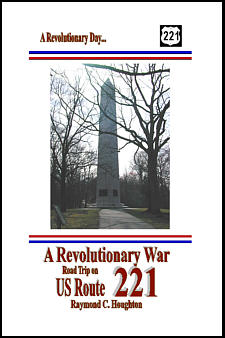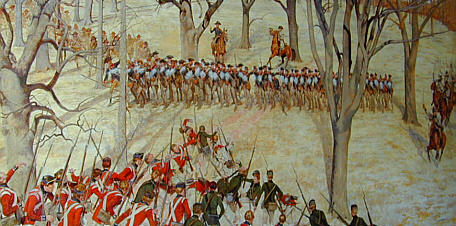A REVOLUTIONARY DAY ALONG
|
 |
A REVOLUTIONARY DAY ALONG
|
 |
 US
Route 221 extends from Virginia to Florida. Through South Carolina and Georgia,
it parallels sites in the southern Backcountry that heated up during the last
half of the Revolutionary War.
US
Route 221 extends from Virginia to Florida. Through South Carolina and Georgia,
it parallels sites in the southern Backcountry that heated up during the last
half of the Revolutionary War.
After an initial 1775-1776 assault on the south by British Regulars and Loyalists was repulsed by American Patriots, the south, for the most part, was quiet for the first half of the Revolutionary War. The southern colonies were, therefore, able to organize their governments and militias in support of the Patriot cause. Meanwhile, Loyalists in the south were forced to put their support for the British Crown under wraps.
After the American victory at Saratoga, the turning point of the war, and the entry of France as an American ally, the British turned their attention to the south. Instead of separating New England from the rest of the colonies, they hoped to separate the southern colonies from the northern colonies. To help accomplish the split, the British believed they would encounter more Loyalist support in the south then they found in the north.
The British invasion of the south began very well. They captured Savannah in December of 1778 and repulsed an American assault to retake Savannah in October of 1779. In May of 1780, General Benjamin Lincoln, commander of the Southern Department of the Continental Army, surrendered to General Henry Clinton, commander of the British Army at Charleston. Later in August, General Horatio Gates, the commander of an American force sent by General George Washington to rescue the south, was defeated at Camden.
While enjoying the success of these major military victories, the British rallied the support of the Loyalists in the Backcountry. They set up a screen of garrison outposts at Augusta, Ninety Six, Hanging Rock, Camden, Cheraw, Rocky Mount and Georgetown. Not only did these outposts serve as points to recruit Loyalist support but they were also positions from which expeditions were sent into the countryside to gather food and ensure order.
By the mid-1780’s, the British had established control over much of the south. They attempted to keep control through pacification efforts and paroles for those that had supported the Patriot cause. However, the British plan began to backfire when the Loyalists, freed of Patriot dominance, began to settle old scores.
Adding flame to the fire was Clinton's proclamation stating that those who did not serve in the Loyalist militia were to be "considered as enemies and rebels." This proclamation not only angered those who wanted to remain neutral but it also served as an excuse for some Loyalists to strike back at the Patriots. As a result, some Patriots believed that their paroles had been violated because they had initially been told they could remain neutral.
After Tory raiders plundered some of their homes, the Patriots began to rearm and reassemble into their old units. In the fall of 1780, several small actions took place in the Backcountry as local groups jockeyed for control. It was rapidly becoming clear to the British that the south was not pacified and was on the verge of open warfare.

In December 1780, Washington sent the “Fighting Quaker,” Major General Nathaniel Greene, to join the fray and attempt to direct operations in the south. Greene took control of the battered remnants of the Southern Department of the Continental Army in North Carolina and marched into South Carolina.
Greene had three things going in his favor: (1) the British were dispersed into small, scattered garrisons; (2) the Patriots were gathering strength, striking isolated garrisons and supply trains; and (3) the British were not certain where to concentrate their forces. The British lack of focus aided American efforts throughout the summer of 1781. By late fall, the British were limited to minor coastal posts between garrisons at Charleston, SC and Savannah, GA.
Greene's success was based on his ability to keep his forces in the field where they could delay, divide, and eventually defeat the British. Greene cooperated with and tried to coordinate with the Patriot militia. He maneuvered against major garrisons and kept the British off balance. While larger forces engaged in battles at Kings Mountain, Cowpens and a siege at the Ninety Six Outpost, smaller forces destroyed the infrastructure on which the British depended for resupply and Loyalist support.
Ultimately, without winning a single battle himself, Greene won the “war of posts.” By keeping his army in the field and offering battle, he forced the British to come to him. Coupled with failing supplies, summer heat, and raiding Patriots, British efforts were at a loss as they could not destroy Greene's main force or maintain their garrison posts.
 A
Revolutionary Day along Historic US Route 221 begins early in the morning on
Route 221 in Chesnee, SC, a site on the Overmountain Victory National Historic
Trail. From Chesnee, the road trip heads east to the Cowpens National
Battlefield where American troops under Brigadier General Daniel Morgan won a
major victory over a British force commanded by Lieutenant Colonel Banastre
Tarleton.
A
Revolutionary Day along Historic US Route 221 begins early in the morning on
Route 221 in Chesnee, SC, a site on the Overmountain Victory National Historic
Trail. From Chesnee, the road trip heads east to the Cowpens National
Battlefield where American troops under Brigadier General Daniel Morgan won a
major victory over a British force commanded by Lieutenant Colonel Banastre
Tarleton.
From Cowpens, the road trip heads south through Gaffney to the Kings Mountain National Military Park where there was another major American Victory by the Overmountain Men over Loyalist forces under Patrick Ferguson.
From Kings Mountain the road trip continues south through York, Historic Brattonsville, the Blackstock Battlefield and Musgrove Mill to the Ninety Six National Historic Site, which was an important British outpost that was abandoned after America’s longest siege of the Revolutionary War.
From Ninety Six, the road trip crosses the Savannah River into Georgia for a visit to the Elijah Clark State Park. The road trip concludes in Augusta, which was the Revolutionary War capital of Georgia that changed hands several times during the war.
So, if you're ready
